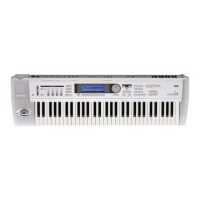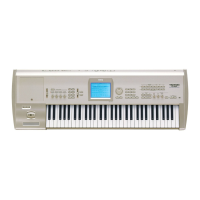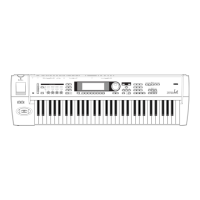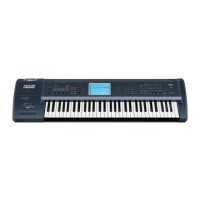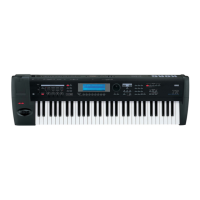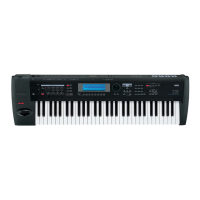10. MIDI applications
64
Adjusting the stereo location (pan)
The oscillators, timbres, and tracks of the TRINITY series can be sent to outputs L and R, and
effect sends 1 and 2 (1 and 2 are the effect inputs). The Pan setting determines how the sound is
divided between outputs L and R. (The effect send settings determine the levels sent to 1 and 2.)
Panning for timbres and tracks can be set by MIDI Pan messages [Bn, 0A, vv] (control change #10:
‘vv’ = value, where 00 is left, 64 is center, and 127 is right). If the Pan setting is OFF or PRG, these
messages will not be received.
If a Pan message is received while a note is sounding, the stereo location of the sound will not
change immediately. The new location will apply from the next-played note.
Effect send levels (send 1,2)
The oscillators, timbres, and tracks of the TRINITY series can be sent to outputs L and R, and
effect sends 1 and 2 (1 and 2 are the effect inputs). The Send 1 and Send 2 settings determine the
levels of the sound sent to 1 and 2. (The Pan settings determine how the sound is divided between
outputs L and R.)
For timbres and tracks, the Send 1 level can be set by MIDI Effect 3 Level messages [Bn, 5B, vv]
(control change #93: ‘vv = value), and the Send 2 level can be set by MIDI Effect 1 Level messages
[Bn, 5D, vv] (control change #91: ‘vv = value). If Send 1 and 2 are set to PRG, these messages will
not be received.
These messages are defined merely for use in adjusting effect levels, so when they are sent to other
instruments, they will not necessarily have the same result.
If these messages are received while a note is sounding, the change in effect send level will not
occur immediately, but will take effect from the next played note.
Turning effects on/off
Independently from the program, combination, and song settings, Global mode P1 allows you to
turn insert effects and master effects E1 (modulation-type) and E2 (reverb/delay-type) on/off. At
the same time, MIDI Effect 2 Level messages [Bn, 5C, vv] (control change #92: ‘vv’ = value, where
00 is OFF and 127 is ON) (for Insert Effects), MIDI Effect 4 Level messages [Bn, 5E, vv] (control
change #94: for master effect E1), and MIDI Effect 5 Level messages [Bn, 5F, vv] (control change
#95: for master effect E2) will be transmitted.
These messages are defined merely for use in turning effects on/off, so when they are sent to other
instruments, they will not necessarily have the same result.
These messages are transmitted and received on the Global MIDI channel, and when a message is
received, the respective effect will be turned on/off (‘vv’ of 00 is OFF, and ‘vv’ of 1 or greater is
ON).
These messages can control insert effects only if the effect is ON. (It is not possible to turn on an
effect that is initially off.)
Effect dynamic modulation
Effects can be controlled by selecting a dynamic modulation source and operating that source.
Most of the modulation sources are common to the alternate modulation sources, but MIDI con-
trol 1 and 2 are only for dynamic modulation.
● If the assignable pedal function is set to Effect Control 1, the pedal will control the effect whose
modulation source is set to MIDI Control 1. At the same time, MIDI Effect Control 1 messages
[Bn, 0C, vv] (control change #12: ‘vv’ = value) will be transmitted.
When this message is received, the effect whose modulation source is set to MIDI Control 1 will
be controlled.
This message is received for the master effects on the Global MIDI channel.
● The modulation source MIDI Control 2 corresponds to the MIDI Effect Control 2 message [Bn,
0D, vv] (control change #13), and can be used in the same way as Effect Control 1.
In Program Play mode, insert effects can be controlled on the Global MIDI channel. In Combina-
tion Play mode, they can be controlled on the MIDI channel of each timbre. In Sequencer mode,
they can be controlled on the MIDI channel of each track.

